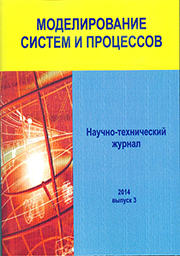from 01.09.2017 until now
Voronezh, Voronezh, Russian Federation
UDC 355.7
Analysis of the masking process indicates the production of a large number of calculations that ensure the validity of relevant decisions. Nevertheless, the clear formulations of information and calculation tasks and methods for the distribution of forces and means involved in the implementation of the masking process are poorly developed, and for some practical cases are absent. The purpose of the article is to develop a set of mathematical models of information and calculation problems and methods for solving them to increase the effectiveness of masking military formations. Among the tasks of masking are the following: an operational assessment of the information capabilities of enemy reconnaissance systems (means) and the amount of information required by its governing bodies to make decisions regarding valid and false intentions; determination of the number of forces and means necessary and sufficient for the execution of masking measures, as well as the operational tactical significance of masking measures; formation and assessment of the quality of the optimal option for the distribution of forces and means; evaluation of masking efficiency and possible degree of achievement of its goal (enemy deception). The developed set of information and calculation tasks for masking is designed to increase the effectiveness of masking of military formations due to the optimal distribution of the forces and means involved. The proposed methodology for assessing the effectiveness of masking military formations, based on the provisions of probability theories and information, makes it possible to comprehensively assess the qualitative characteristics of the ongoing operational masking activities.
Operative masking, unmasking features, real and false objects, detection probability, hiding factor, imitation factor, linear programming, non-linear programming
1. Voennaya razvedka / Pod redakciey: P. Robinsona i R.N. Puhova. – M.: Centr analiza strategiy i tehnologiy, 2021. – 376 s.
2. Voennoe iskusstvo v lokal'nyh voynah i vooruzhennyh konfliktah / A.V. Usikov, A.D. Borschov, G.A. Burutin [i dr.] / pod obschey red. A.V. Rukshina. – M.: Voenizdat, 2008. – 765 s.
3. Markov, K.A. Maskirovka v voennyh konfliktah konca XX – nachala XXI veka / K.A. Markov // Voenno-istoricheskiy zhurnal. – 2018. – URL: http://history.milportal.ru/maskirovka-v-voennyx-konfliktax-konca-xx-nachala-xxi-veka(data obrascheniya 18.09.2021).
4. Optimization of color design for military camouflage in CIELAB color space / Ch.J. Lin, Yo.T. Prasetyo, N.D. Siswanto, B.C. Jiang. // Color Research & Application. – 2019. – Vol. 44, № 3. – Pp. 367–380.
5. Maruschenko, P. Voennaya hitrost' v istorii voyn / P. Maruschenko, A. Valeev // Armeyskiy sbornik. – 2018. – № 10. – S. 61-66.
6. Staver, A.A. Maskirovka boevoy tehniki. Vvedenie protivnika v zabluzhdenie / A.A. Staver // Voennoe obozrenie. – 2019. – URL: https://topwar.ru/163067-blef-vizhu-ne-vizhu-ne-pojmu-chto-vizhu.html(data obrascheniya 18.09.2021).
7. Lin, Ch. J. A metaheuristic-based approach to optimizing color design for military camouflage using particle swarm optimization / Ch.J. Lin, Yo.T. Prasetyo // Color Research & Application. 2019. – Vol. 44, № 5. – Pp. 740–748.
8. Milic, A. Camouflage in resource protection function / A. Milic, A. Ranđelović, M. Radovanović // Proceedings of the 5th International Scientific and Professional Conference “Security and Crises Management – Theory and Practice SeCMan 2019”. – Belgrade, Regional association for security and crisis management: S4 GLOSEC Global security, 2019. – Pp. 98–104.
9. Freyman, V.A. Razvitie perspektivnyh sredstv maskirovki voennoy tehniki i vooruzheniya / V.A. Freyman, S.V. Brynyuk // Aktual'nye problemy voenno-nauchnyh issledovaniy. – 2020. – № 11(12). – S. 491-504.
10. Vzglyady komandovaniya NATO na primenenie vysokotochnogo oruzhiya v boyu. – Rezhim dostupa: https://revolution.allbest.ru/war/00801355_0.html(data obrascheniya 18.09.2021).
11. Modeli informacionnogo konflikta sredstv poiska i obnaruzheniya / pod red. Yu.L. Kozirackogo. – M.: Radiotehnika, 2013. – 232 s.
12. Korobkov, S.P. Obosnovanie racional'nogo varianta postroeniya sistemy radiolokacionnoy razvedki soedineniya PVO pri bor'be s giperzvukovymi i ballisticheskimi sredstvami protivnika / S.P. Korobkov, A.A. Nerastenko, A.G. Sozykin // Voennaya mysl'. – 2018. – № 3. – S. 9-13.
13. Boev, A. Vozdushnaya sistema razvedki nazemnyh celey i upravleniya naneseniem udarov / A. Boev // Zarubezhnoe voennoe obozrenie. – 2015. – № 10. – S. 68-70.
14. Exact algorithms for multiobjective linear optimization problems with integer variables: A state of the art survey / P. Halffmann, L.E. Schäfer, K. Dächert, K. Klamroth, S. Ruzika // Journal of Multi-Criteria Decision Analysys. – 2022. – № 29. – Pp. 341–363.
15. Ventcel', E.S. Teoriya veroyatnostey: ucheb. dlya vuzov / E.S. Ventcel'. – M.: Vyssh. shk., 2006. – 575 s.
16. Schulz, S, A multi-objective iterated local search algorithm for comprehensive energy-aware hybrid flow shop scheduling / S. Schulz, J.S. Neufeld, U. Buscher // Journal of Cleaner Production. – 2019. – T. 224. – Pp. 421-434.
17. Girish, B.S. Minimizing the total weighted earliness and tardiness for a sequence of operations in job shops / B.S. Girish, D.J. Habibullah // RAIRO-Operations Research. – 2022. – T. 56. – Pp. 2621-2649.
18. Taha, K. Methods That Optimize Multi-Objective Problems: A Survey and Experimental Evaluation / K. Taha // IEEE Access. – 2020. – № 8. – Pp. 80855-80878.
19. A Survey on Modeling and Optimizing Multi-Objective Systems / J.-H. Cho, Y. Wang, I-R. Chen [et al.] // IEEE Commun Surveys & Tutorials. – 2017. – T. 19, № 3. – Pp. 1867-1901.
20. Sona Babu, B.S. Pareto-optimal front generation for the bi-objective JIT scheduling problems with a piecewise linear trade-off between objectives / B.S. Sona Babu // Girish Operations Research Perspectives. – 2024. – № 12. – S. 100299.








